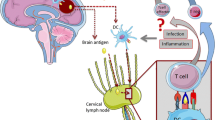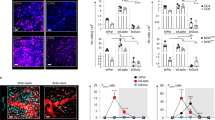Abstract
Six cases of middle cerebral artery occlusion are presented in which the cellular changes accompanying descending degeneration of the lateral corticospinal tract were studied at different time points (5 days–10 years) following the insult. Microglia and perivascular cells were found to ingest large amounts of myelin degradation products, while expressing high levels of major histocompatibility complex (MHC) class II molecules. Activation of perivascular macrophages, as indicated by increased class II expression, lasted for many years and appeared to follow down-regulation of both phagocytic activity and class II expression on parenchymal microglia. TUNEL labeling was absent from both microglia and perivascular cells at all time points investigated. Indirect evidence is presented that microglia may transfer myelin degradation products to the perivascular space. Perivascular cells which express MHC class II molecules constitutively do not appear to leave the perivascular compartment in large numbers and could release myelin degradation products into the cerebrospinal fluid. The possible immunological consequences of these findings are discussed with respect to their possible relevance for antigen presentation and autoimmune central nervous system disease.
Article PDF
Similar content being viewed by others
Avoid common mistakes on your manuscript.
Author information
Authors and Affiliations
Additional information
Received: 17 April 1997 / Revised, accepted: 23 June 1997
Rights and permissions
About this article
Cite this article
Kösel, S., Egensperger, R., Bise, K. et al. Long-lasting perivascular accumulation of major histocompatibility complex class II-positive lipophages in the spinal cord of stroke patients: possible relevance for the immune privilege of the brain. Acta Neuropathol 94, 532–538 (1997). https://doi.org/10.1007/s004010050747
Issue Date:
DOI: https://doi.org/10.1007/s004010050747




